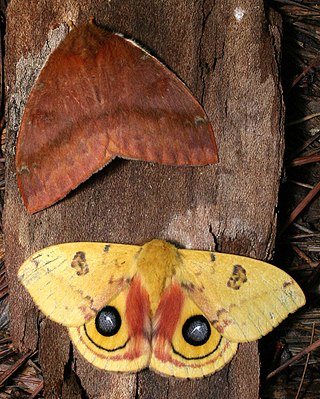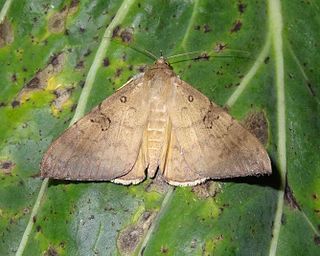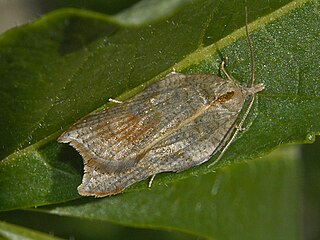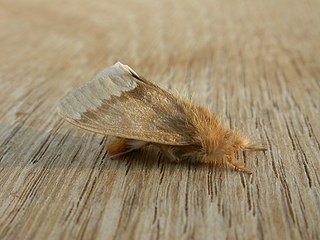
The Australian hornet is not a true hornet, it is a type of potter wasp or "mason wasp", is a vespid native to the Australian states and territories of the Australian Capital Territory, New South Wales, Northern Territory, Victoria, Queensland and Western Australia.

The brown-tail moth is a moth of the family Erebidae. It is native to Europe, neighboring countries in Asia, and the north coast of Africa. Descriptions of outbreaks, i.e., large population increases of several years duration, have been reported as far back as the 1500s. The life cycle of the moth is atypical, in that it spends approximately nine months as larvae (caterpillars), leaving about one month each for pupae, imagos and eggs. Larvae (caterpillars) are covered in hairs. Two red spots on the back, toward the tail, distinguish these species from other similarly hairy moth larvae. The winged adults have white wings and a hairy white body with a tuft of brown hair at the tip of the abdomen. Females lay one egg cluster, usually on the underside of a leaf of a host plant. The species is polyphagous, meaning that it feeds on many different species of trees, including pear, apple, maple and oak.

The yellow-tail, goldtail moth or swan moth is a moth of the family Erebidae. The species was first described by Johann Kaspar Füssli in 1775, and has commonly been placed within the related genus Euproctis. It is distributed throughout Europe to the Urals, then east across the Palearctic to Siberia and south to India and Sri Lanka.

Automeris io, the Io moth or peacock moth, is a colorful North American moth in the family Saturniidae. The Io moth is also a member of the subfamily Hemileucinae. The name Io comes from Greek mythology in which Io was a mortal lover of Zeus. The Io moth ranges from the southeast corner of Manitoba and in the southern extremes of Ontario, Quebec, New Brunswick and Nova Scotia in Canada, and in the US it is found from Montana, North Dakota, South Dakota, Nebraska, Colorado, New Mexico, Texas, Utah, east of those states and down to the southern end of Florida. The species was first described by Johan Christian Fabricius in 1775.

Theretra oldenlandiae, the impatiens hawkmoth, taro hornworm or white-banded hunter hawkmoth, is a member of the family Sphingidae.

Grammodes geometrica is a moth found from the Mediterranean east to Oriental and Australasian tropics of India, Sri Lanka, Java and Australia. The adult is a fruit piercer. The species was first described by Johan Christian Fabricius in 1775.

Hippotion boerhaviae, the pale striated hawkmoth, is a moth of the family Sphingidae.

Brithys crini, the amaryllis borer, crinum borer, lily borer or Kew arches, is a moth of the family Noctuidae. It is a garden pest in parts of its range, as their larvae damage the stems and leaves of lilies, especially lilies of the family Amaryllidaceae.

Anomis flava, the cotton looper, tropical anomis or white-pupiled scallop moth, is a moth of the family Erebidae. The species was first described by Johan Christian Fabricius in 1775. It is found in large parts of the world, including China, Hawaii, São Tomé and Príncipe, the Society Islands, Thailand, New Zealand, and Australia. Subspecies Anomis flava fimbriago is found in North America.

Oxyodes scrobiculata, the longan semi-looper or longan leaf-eating looper, is a moth of the family Erebidae. The common name "looper" is used despite looper moths generally being in the family Geometridae. The species was first described by Johan Christian Fabricius in 1775. It is found in the Indo-Australian tropics of India, Sri Lanka, Myanmar, China, Taiwan, east to Guam, Queensland, New Caledonia, Fiji, Samoa and Tonga.

Crocidolomia pavonana is a moth of the family Crambidae. Its caterpillar is a crop pest and is known as the croci or the cabbage cluster caterpillar. This moth is found in Africa and Asia, its range extending from South Africa through India to the Pacific Ocean, including Australia. The wingspan is about 25 mm (1 in). The larvae feed on Brassicaceae species and are considered an agricultural pest on cabbages. The species was first described by Johan Christian Fabricius in 1794.

Acleris emargana, the notched-winged tortricid, is a moth of the family Tortricidae. The species was first described by Johan Christian Fabricius in 1775.

Euproctis baliolalis, the browntail gum moth, is a moth of the family Erebidae. The species was first described by Charles Swinhoe in 1892. It is found in the south-east quarter of Australia.

Hypocala deflorata is a moth of the family Erebidae. It was first described by Johan Christian Fabricius in 1794. It is widespread from India, Sri Lanka to Africa and to Australia and many Pacific islands. Records include China, Borneo, Queensland, Vanuatu, New Caledonia, Rotuma, Fiji, Samoa, Hawaii, Norfolk Island and New Zealand.

Nudaurelia cytherea, also called the pine tree emperor moth or Christmas caterpillar due to its festive colouration, is a southern African member of the family Saturniidae. The family has large edible caterpillars which are an important source of protein for the Bantu peoples of southern Africa. The genus Nudaurelia is closely related to Gonimbrasia and Imbrasia. The species was first described by Johan Christian Fabricius in 1775.

Arugisa lutea, the common arugisa moth, is a species of moth in the family Erebidae. The species was first described by John B. Smith in 1900. It is found in the United States, where it has been recorded from Maryland and Virginia to Florida, west to Texas and Missouri.

Loboschiza koenigiana, the orange tortricid moth or leaf webber, is a moth of the family Tortricidae. The species was first described by Johan Christian Fabricius in 1775. It is found in the United Arab Emirates, Pakistan, India, Sri Lanka, Myanmar, China, Malaysia, Thailand, Java in Indonesia, New Guinea, Queensland in Australia, the Philippines, Taiwan, Japan and Korea.


















